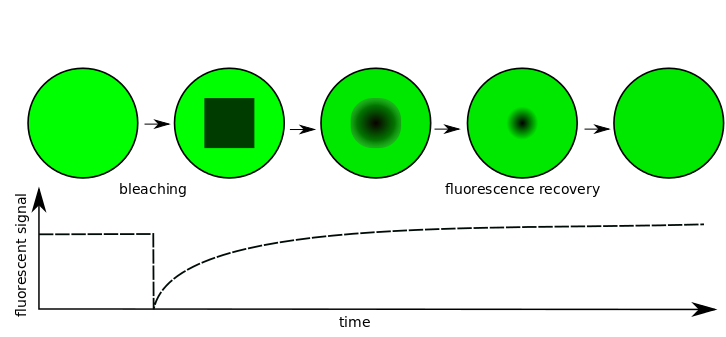-
Notifications
You must be signed in to change notification settings - Fork 8
Home
Fluorescence Recovery After Photobleaching (FRAP) is a microscopy-based technique for measuring protein mobility. A fluorescent sample is exposed to a high-intensity pulse in a small region (ROI) of the sample, bleaching the fluorescence of the molecules within this region. Over time, the fluorescence in the bleached ROI recovers, resulting in a recovery curve that can be exploited to compute the rate of diffusion underlying this recovery.

Fluorescence Recovery After Photobleaching (FRAP) is a common way to assess molecular diffusion. PyFRAP is a novel simulation-based analysis software that makes use of PDE simulations to analyze FRAP experiments in 3D geometries. It uses the first post-bleach image as initial condition, making assumptions about the underlying initial conditions obsolete. PyFRAP can fit different reaction-diffusion models to FRAP data, providing quantitative information about effective diffusion.
PyFRAP comes with a full image analysis and simulation toolbox. In particular, PyFRAP can
- Import FRAP datasets from timelapse experiments and analyze image data with various options such as
- image filters
- background subtraction
- illumination correction
- Simulate the FRAP experiment with exact interpolated initial conditions
- Fit simulated experiment to analyzed data and extract diffusion coefficient
- Statistical analysis of fitting results
- Hierarchical data structure making data exchange/sharing easy
- Comprehensive GUI, making almost all PyFRAP tools available
In this wiki we explain how to
- Properly install PyFRAP,
- Analyze your first FRAP experiments with the PyFRAP GUI,
- Use the PyFRAP package for scripting and running in the command line,
- Use PyFRAP's ROI definition tool to define arbitrary ROIs,
- Use PyFRAP's meshing capabilities to optimize your tetrahedral mesh to obtain optimal simulation results and construct geometries in PyFRAP.
Need help? Found a bug? Want to more about PyFRAP, FRAP? Don't hesitate to message alexander.blaessle@gmail.com or use the issue tracking system.